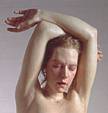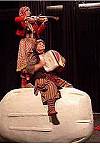I’ve been sculpting with clay the last few days, a favourite activity. I love the feel of it, and how malleable yet solid it is. These days it always makes me think about an interview with Paulus Berensohn that I heard a while ago on the ABC’s Earthbeat program. Berensohn is a Deep Ecologist and craft artist, and he is best known for his book Finding One’s Way With Clay. I was taken with some of the things he says in the interview. Here are a few examples:
“But I started in my late teens as a dancer, and was a dancer until I was 30 and then one night in the middle of a performance, at a climax in the dance where we then had to freeze, a voice in my head said, ‘This is dancing on a stage, what does it mean to dance in life?’ And very shortly after that, I was taken to a picnic, and there was a great American potter there, and I watched her throwing on the wheel, and I made that connection that the act of throwing clay on a potter’s wheel was a kind of dancing. And I was just enchanted, and wanted to learn that dance”…
“I mean I personally think that the craft arts isn’t about an alternative way of making a living and filling museums and galleries with gorgeous objects, I think it’s the clay and the fibre and the metals and the wood saying ‘Listen, listen to me. Put your hands on me, and you’ll make contact with a living world.’ “…
“The word ‘art’, if you go back into its etymological roots, it’s not a noun, it’s a verb, it’s a doing, an acting, and it comes from the root for ‘to join’. So one is behaving artistically, one is in a state of intimacy and communion with the activity at hand”…
“We have in our DNA the memory of having fur and a memory of having whiskers that connected us to nature”…
“The first time I ever encountered an Aboriginal Australian, was in New Mexico, and they had invited an Aboriginal elder to come to speak to the native Americans and he was, I wish I remembered his name, he was wonderful. And he came with slides of stones and sunsets and sunrises. He would show a sunrise, and he would say, ‘This is a sunrise in Australia; you must watch the sunrise every day, it is a blessing for Mother Earth’, and then he would show a sunset, and he would say, ‘You must watch the sun set.’ “…
“So one of the things in journals you can do is keep lists, and one of the lists I keep is Who else is here? Who else is participating in this life? So like in these months that I’ve been on Tasmania, yes, here’s one I wrote: 2 Huntsman spiders, one on the lid of the compost toilet. The other was inside a straw hat of Peter’s which he wore for five minutes before he felt something crawling on his head. Luckily he took of his hat before it bit him. It was at least four inches across. Four possums by the side of the road as we drove home late from Hobart last night. Red tide in Nubena threatening the salmon farming pens. Gustav says they are dinoflagellates and that what Peter and I saw my first night here as a phosphorescent tide is the same as the red tide. See, I never knew that”…
“It’s the artist’s work to sing up the earth, to praise and thank and to express gratitude. Well that’s what I think art is. That’s why I think art is a behaviour, to sing up the earth.”
 I got chatting to someone out at Walker Ceramics in Fyshwick yesterday, who was telling me about an installation that took place in the CSIRO Discovery Centre late last year. Ken Yonetani, a post graduate student working in ceramics at the Canberra School of Art, made 2000 tiles, each 30cm square and only about 5mm thick, fired in the Japanese ‘fumie’ style tradition. The tiles took about 6 months to make, and were white and fragile, with an image of one of 6 different endangered butterflies cast in relief on each one. They were then laid wall-to-wall on the floor in various spaces in the Discovery Centre, and the people who had gathered for the launch were invited in… Within a short time the tiles were broken into tiny pieces. Jeff Doyle’s article in the Journal of Australian Ceramics, ‘Ken Yonetani’s installation at CSIRO Discovery, ACT’ gives pictures and details of the installation, including the reactions as people realised the implicit metaphor involved in the destruction. Cool stuff!
I got chatting to someone out at Walker Ceramics in Fyshwick yesterday, who was telling me about an installation that took place in the CSIRO Discovery Centre late last year. Ken Yonetani, a post graduate student working in ceramics at the Canberra School of Art, made 2000 tiles, each 30cm square and only about 5mm thick, fired in the Japanese ‘fumie’ style tradition. The tiles took about 6 months to make, and were white and fragile, with an image of one of 6 different endangered butterflies cast in relief on each one. They were then laid wall-to-wall on the floor in various spaces in the Discovery Centre, and the people who had gathered for the launch were invited in… Within a short time the tiles were broken into tiny pieces. Jeff Doyle’s article in the Journal of Australian Ceramics, ‘Ken Yonetani’s installation at CSIRO Discovery, ACT’ gives pictures and details of the installation, including the reactions as people realised the implicit metaphor involved in the destruction. Cool stuff! Ron Mueck’s sculpture has reminded me of the Melbourne artist Patricia Piccinini. Apart from
Ron Mueck’s sculpture has reminded me of the Melbourne artist Patricia Piccinini. Apart from  One of the recent acquisitions at the
One of the recent acquisitions at the 
 A 3′ x 5′ sculpted foam rubber foot has mysteriously been
A 3′ x 5′ sculpted foam rubber foot has mysteriously been 


